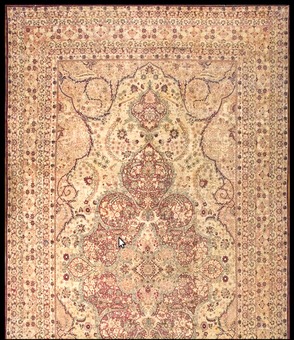Antique handmade oversized carpet No. 37486 Kerman Lavar, ca. 1880 Iran 635 x 340 cm

Larger images (will open in new window)
Please click on the thumbnails below for a larger view
| main view |
 |
| Item Number: |
37486 |
| Name: |
Kerman Lavar, ca. 1880 |
| Country of Origin: |
Iran |
| Size: |
635 x 340 cm |
| Made:
|
ca. 1880 |
| Pile: |
wool |
Foundation
(warp and weft): |
cotton |
| Design: |
floral / medallion |
| Ground Color: |
ivory |
| Remarks: |
This is a unique handmade / hand-knotted / traditional oriental carpet
The pile of this carpet is made of wool
Cashmir wool, partly painted. This piece has been dyed with vegetable dyes only. |
 add to cart
add to cart
More about the provenance Kerman Lavar, ca. 1880 | Iran
Kerman is the capital city of the province of the same name. Kerman rugs have already been mentioned by the secretary of Shah Abbas I. (1587-1629) who spoke of "rugs with gold and silber threads". There are Kerman rugs preserved to this day since the 16th century throughout each century. Since the end of the 19th century until today Kerman with its large and esteemed rug manufactories is considered to be one of the most significant carpet production centers of Iran. Kerman is probably the only larger city of Iran whose population in its majority lives of carpet production. The most famous of the ca. 30 villages around Kerman in which rugs are made is called Ravar. The Kerman rug is often described as the "King of the carpets - the carpet of Kings". The Persian knot is used making them as opposed to the more spread Turkish knot which is more often used with Persian rugs.
The wool of this rug has been dyed with vegetable dyes only which became very rare in Oriental rugs. Since ca. 1850 synthetic dyes found their way into carpet production. Ever since they replaced natural vegetable dyes more and more also due to the fact that the production of vegetable dyes is very time consuming and difficult. But the "aura of genuineness" can be reached to its full extent with vegetable dyes only. Vegetable dyes are made from leaves, flowers, branches, fruits and roots. They give Oriental rugs a particularly harmonic look. In general Oriental rugs "age" better and more beautifully with vegetable dyes than with synthetic dyes plus they increase a carpet's value. Most of today's production is made with synthetic dyes which makes this rug an even more desirable piece. Unfortunately many rugs in the market are being labelled as being vegetable dyed which in many colors is simply not true which damages the reputation of the carpet industry altogether.

